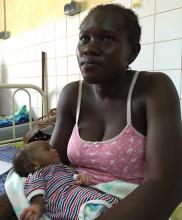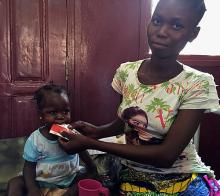Youngest victims of the health crisis in Central African Republic
 26 November 2015: “I was on my way home from the school when my bus came under fire,” says 11-year-old Niatou Christy Judicael, who was injured in both legs on 4 November when his bus was shot at with automatic weapons. The recent flare in violence in Bangui, the capital of Central African Republic, has seen an increasing number of wounded children being admitted to Bangui PaediatricComplex, the country’s only functioning health structure still providing specialized care for children.
26 November 2015: “I was on my way home from the school when my bus came under fire,” says 11-year-old Niatou Christy Judicael, who was injured in both legs on 4 November when his bus was shot at with automatic weapons. The recent flare in violence in Bangui, the capital of Central African Republic, has seen an increasing number of wounded children being admitted to Bangui PaediatricComplex, the country’s only functioning health structure still providing specialized care for children.
“We are overwhelmed and often we have 2, even 3, children sharing a bed,” explains Assaye Abel, acting director of the hospital.
With just over 300 beds and only 15 medical doctors, the hospital provides free paediatric services including newborn care, vaccination, intensive care, malnutrition treatments and surgical interventions. Each day 250 patients are admitted to Bangui Paediatric Complex, with the majority suffering from malaria, diarrhoea or malnutrition.
“Because of insecurity, health centres across Bangui are closed at night. All emergency cases come to our hospital while, in my unit, we have only half of the qualified personnel that we need,” says Dr Nganda Bangue Marie-Collette, deputy head of the intensive care unit. ”We see lots of children with severe malaria, meningitis and newborn infections”.
Children at risk
Since the beginning of 2014, Central African Republic has been facing recurrent crises that have heavily affected the already-weak health system. A WHO survey in 2014 found that 213 health facilities – 1 in 4 of the country’s facilities – are dysfunctional. Many others are only partially functional.
Lack of health professionals, damaged health facilities and lack of equipment and medicines have left many people without access to basic health care.
About 139 children out of every 1000 live births die before their 5th birthday. In Central African Republic, there are only 250 medical doctors, that is 1 doctor per 20 000 people, almost 4 times less than the African average.
In 2014, only 41% of babies less than 12 months old completed their routine vaccination, resulting in repeated outbreaks of measles in different areas of the country.
Funding gaps
The same WHO survey found that only half of secondary health facilities are able to provide emergency trauma care and less than half of all health staff are community health workers without any consistent training.
“Half of all functioning health facilities in the country are supported by a humanitarian partner, meaning that the health sector is extremely dependent on external funding,” explains Dr Michel Yao, WHO Representative in Central African Republic. “Current funding gaps may leave hundreds of thousands of people without health care.”
Due to lack of resources and skills, WHO is filling the gap with 3 field offices and is planning 2 more. These teams have been crucial in detecting and responding to disease outbreaks. Since the beginning of the crisis, WHO has delivered more than 300 tonnes of medical supplies to health facilities and nongovernmental organizations in all parts of Central African Republic.
However the funding gap is enormous. In 2015, health partners in Central African Republic appealed for US$ 63.2 million but, as of mid-November, less than half of these funds had been received.
“WHO was financially supporting the Bangui Paediatric Complex but we had to stop the project 6 months ago due to the lack of funding,” says Dr Yao.
“Our government does what it can but we still need external support and we are thankful to all humanitarian organizations working with us,” concludes Mr Abel of the Bangui Paediatric Complex, that is currently supported by Action Contre la Faim, Italian organization Emergency, Médecins Sans Frontières, UNICEF and WHO.
__________________________________________
For more information, please contact:
Cory Couillard, Mobile: + 47 24 13 99 95, Email: couillardc [at] who.int (couillardc[at]who[dot]int)
Tarik Jasarevic, Mobile: +41 793 676 214, Email: jasarevict [at] who.int (jasarevict[at]who[dot]int)
__________________________________________
Below:
Photo 1: Dengoude Francine from Bangui, Central African Republic, with her newborn baby who contracted an infection. Francine already has 3 children who have all had malaria. The intensive care unit of Bangui Paediatric Complex reports that half of the children admitted here suffer from severe malaria, the number one child killer in the country.
Photo 2 : The family of NGundire Kinture, 11-year-old diabetes patient, has to buy her insulin in pharmacies as it is not available in health facilities where medicines are free of charge. NGundire was admitted to Bangui Paediatric Complex in a state of coma caused by lack of regular treatment. After a week in the hospital she is now recovering. Health partners in Central African Republic are hoping to include medicines for chronic diseases like diabetes in donation kits.
Photo 3: Dev Bozema, a 10-year-old boy from Bangui, sustained serious injuries when he found an unexploded device near his house. WHO was financially supporting Bangui Paediatric Complex but had to stop the project 6 months ago due to lack of funding. The hospital receives support from Action Contre la Faim, Italian organization Emergency, Médecins Sans Frontières, UNICEF and WHO.
Photo 4: Niatou Christy Judicael, aged 11, was injured in both legs when a bus he took home from school came under fire from automatic weapons. The recent flare in violence saw increasing numbers of wounded children being admitted to Bangui Paediatric Complex.
Photo 5: Bangui Paediatric Complex is now the only place in the Central African Republic providing specialised paediatric health services and it has become the country’s referral hospital. Each day 250 patients are admitted to the hospital. Malaria, diarrhoea and malnutrition are the most common illnesses.
Photo 6: The specialized nutrition ward at Bangui Paediatric Complex is overcrowded with more than 100 patients at any given time for only 76 available beds.








